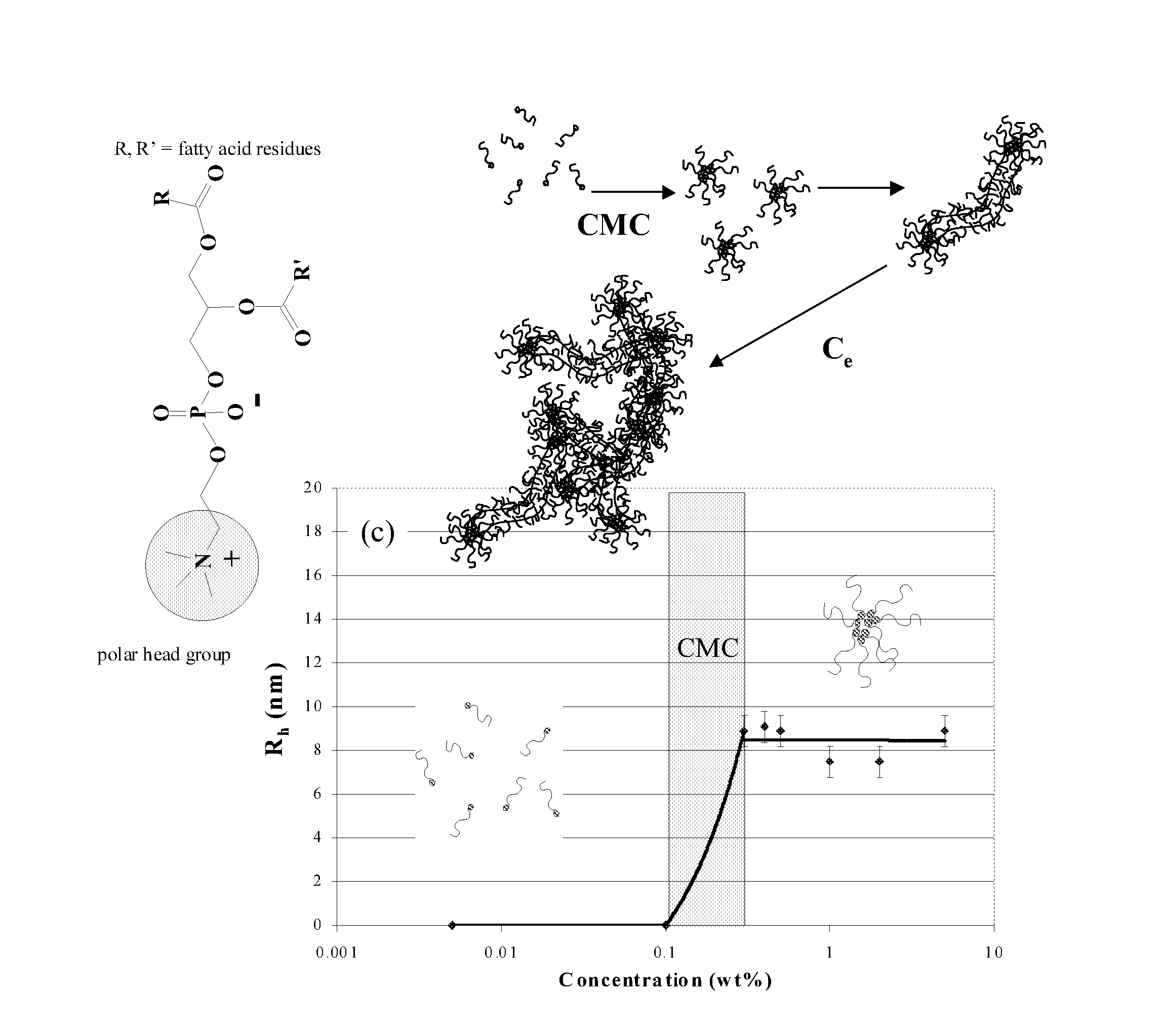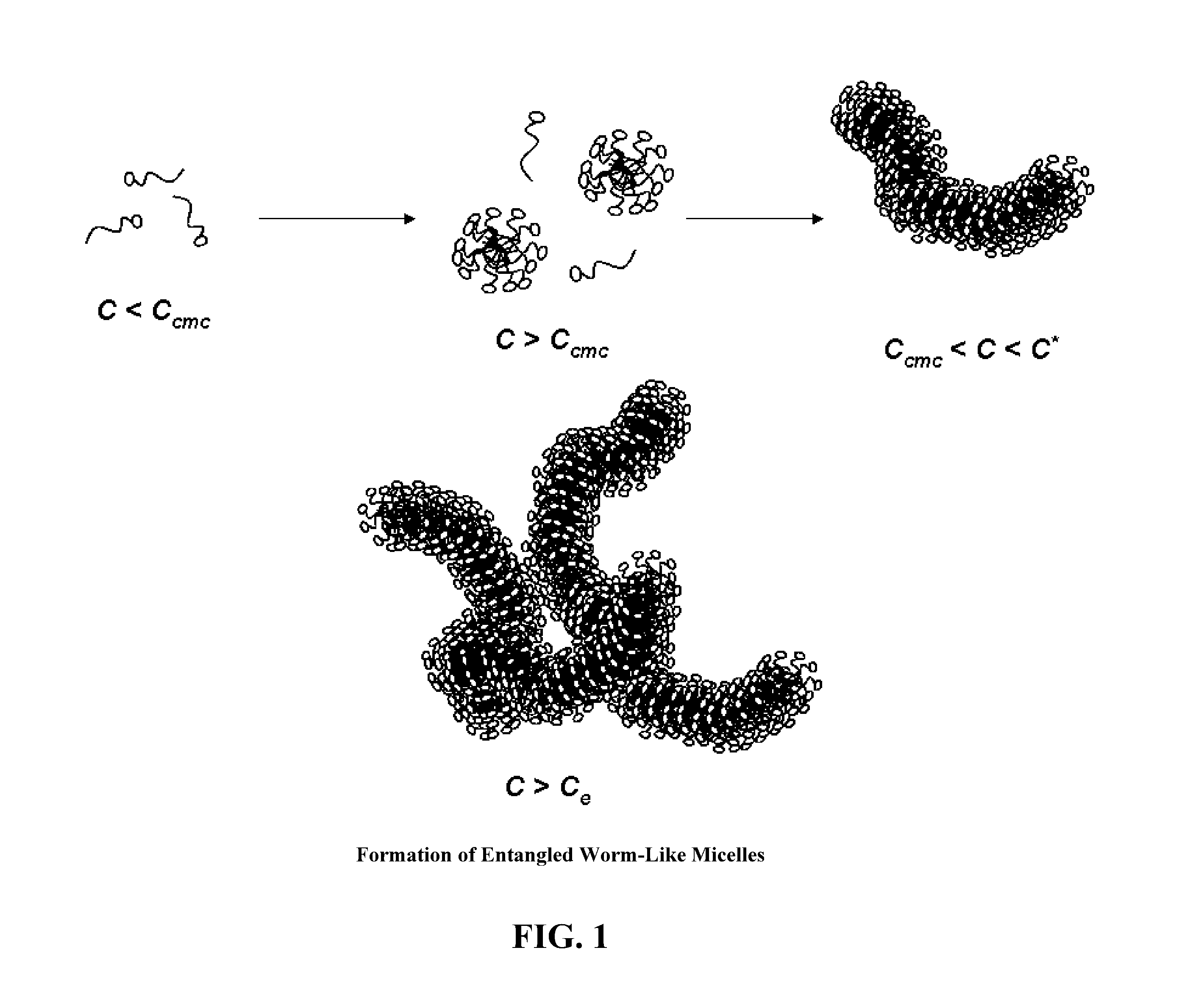Amphiphilic Fibers and Membranes and Processes for Preparing Them
- Summary
- Abstract
- Description
- Claims
- Application Information
AI Technical Summary
Benefits of technology
Problems solved by technology
Method used
Image
Examples
example 1
[0059]Lecithin, a natural mixture of phospholipids and neutral lipids, forms cylindrical or worm-like reverse micelles in nonaqueous solutions. See P. Schurtenberger, R. Scartazzini, L. J. Magid, M. E. Leser, P. L. Luisi, J. Phys. Chem. 94, 3695 (1990). As the concentration of lecithin is raised in solution, the micellar morphology changes from spherical to cylindrical, and at higher concentration the cylindrical micelles overlap and entangle in a similar way to that of polymer chains in semi-dilute or concentrated solution. See S. A. Mezzasalma, G. J. M. Koper, Y. A. Shchipnov, Langmuir 16, 10564 (1998). Water and other polar molecules serve to bridge the phosphate head groups between neighboring phospholipids through hydrogen bonds. See Y. A. Shchipunov, E. V. Shumilina, Mater. Sci Eng. C3, 43 (1995).
[0060]The morphology of lecithin micelles that formed in nonaqueous solutions was probed by using dynamic light scattering and solution rheology, and the concentration dependence of t...
example 2
[0086]Nonwoven mats of electrospun fibers are characterized by their high porosities and well-defined pore sizes. Exemplary fiber diameters and pore sizes are provided in Table 1 for fibers prepared from phospholipid solutions, e.g., 43 and 45 wt % asolectin.
TABLE 143 wt % AsolectinFiber Diameters (μm) (avg = 2.7, std dev = 1.4)1.44.16.23.12.73.02.92.82.90.531.22.02.4Pore Diameters* (μm) (avg = 14.9, std dev = 3.8)21.314.016.811.211.445 wt % AsolectinFiber Diameters (μm) (avg = 4.8, std dev = 1.7)9.46.35.35.03.92.92.65.44.84.43.93.14.9Pore Diameters* (μm) (avg = 18.5, std dev = 4.2)11.623.617.418.121.9*Pore diameters calculated as average cross-sectional distance between fibers.
example 3
[0087]Fibers can be generated from solutions of low molar mass surfactants, such as n-hexadecyl trimethyl ammonium bromide (CTAB), in de-ionized water as well as in 80 / 20 wt % / wt % deionized water / methanol. The addition of sugar, for example, dextrose, can affect overall solution viscosity while not affecting the one-dimensional micellar structure of the surfactants.
[0088]Hexadecyltrimethylammonium bromide (CTAB), a cationic surfactant, can be used to generate fibers and membranes according to the invention. Cationic surfactants are capable of forming worm-like micelles in solution. The amphiphile CTAB, for example, has been shown previously to aggregate into worm-like micelles with viscoelastic properties.
[0089]FIG. 6 shows the steady-shear rheology of CTAB in de-ionized water (DI H2O). FIG. 6 shows Newtonian behavior at lower concentrations and shear-thinning behavior at higher concentrations and shear rates, a behavior analogous to that of polymer solutions.
[0090]FIG. 7 shows the...
PUM
| Property | Measurement | Unit |
|---|---|---|
| Diameter | aaaaa | aaaaa |
| Diameter | aaaaa | aaaaa |
| Diameter | aaaaa | aaaaa |
Abstract
Description
Claims
Application Information
 Login to View More
Login to View More - R&D
- Intellectual Property
- Life Sciences
- Materials
- Tech Scout
- Unparalleled Data Quality
- Higher Quality Content
- 60% Fewer Hallucinations
Browse by: Latest US Patents, China's latest patents, Technical Efficacy Thesaurus, Application Domain, Technology Topic, Popular Technical Reports.
© 2025 PatSnap. All rights reserved.Legal|Privacy policy|Modern Slavery Act Transparency Statement|Sitemap|About US| Contact US: help@patsnap.com



